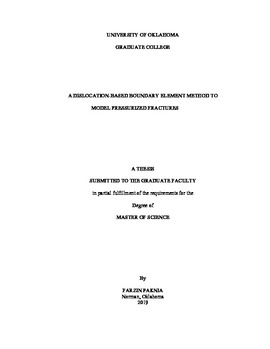| dc.contributor.advisor | Ghassemi, Ahmad | |
| dc.contributor.author | Paknia, Farzin | |
| dc.date.accessioned | 2019-12-13T16:03:32Z | |
| dc.date.available | 2019-12-13T16:03:32Z | |
| dc.date.issued | 2019 | |
| dc.identifier.uri | https://hdl.handle.net/11244/322866 | |
| dc.description.abstract | A significant portion of hydrocarbon and geothermal resources in the world, and especially in the United States, is unconventional. Some of the unconventional resources have special geological structures so that their pores are either very small or very limited and unconnected making them nearly impermeable in comparison to traditional hydrocarbon resources. Hydraulic fracturing is one of the prominent stimulation techniques to improve and enhance unconventional reservoir matrix permeability. The major goal in this research is to develop a semi-analytical method to model/simulate hydraulic fracturing based on closed-form solution of an elastic dislocation problem. Our approach is essentially a simplified form of the Boundary Element Method (BEM). The solution is then used to treat the problems of single and multiple -fractures in infinite and semi-infinite reservoirs. The formulation computes displacements and displacement derivatives caused by a dislocation in a finite rectangular source. The results are compared to benchmark solutions previously published. The model is used to analyze pressurized penny-shaped fractures, stress, and displacement distributions around them. This is done using the stress and displacement derivatives at specified grid nodes (field points) in the domain to calculate Cauchy strains and stresses. The stress components at grid nodes are used to calculate principal stress values and directions. The model is verified by comparison with well-known solutions including the pressurized penny-shaped horizontal fracture. | en_US |
| dc.language | en_US | en_US |
| dc.rights | Attribution-NonCommercial-NoDerivatives 4.0 International | * |
| dc.rights.uri | https://creativecommons.org/licenses/by-nc-nd/4.0/ | * |
| dc.subject | Engineering, Petroleum. | en_US |
| dc.subject | Geophysics | en_US |
| dc.subject | Geomechanics | en_US |
| dc.subject | Hydraulic Fracture Modeling | en_US |
| dc.subject | Boundary Element Method | en_US |
| dc.subject | Dislocation-Based Method | en_US |
| dc.subject | Semi-Analytical Method | en_US |
| dc.title | A DISLOCATION-BASED BOUNDARY ELEMENT METHOD TO MODEL PRESSURIZED FRACTURES | en_US |
| dc.contributor.committeeMember | Wu, Xingru | |
| dc.contributor.committeeMember | Fahes, Mashhad | |
| dc.date.manuscript | 2019-12-02 | |
| dc.thesis.degree | Master of Science | en_US |
| ou.group | Mewbourne College of Earth and Energy::Mewbourne School of Petroleum and Geological Engineering | en_US |
| shareok.orcid | 0000-0001-5111-1235 | en_US |
| shareok.nativefileaccess | restricted | en_US |

